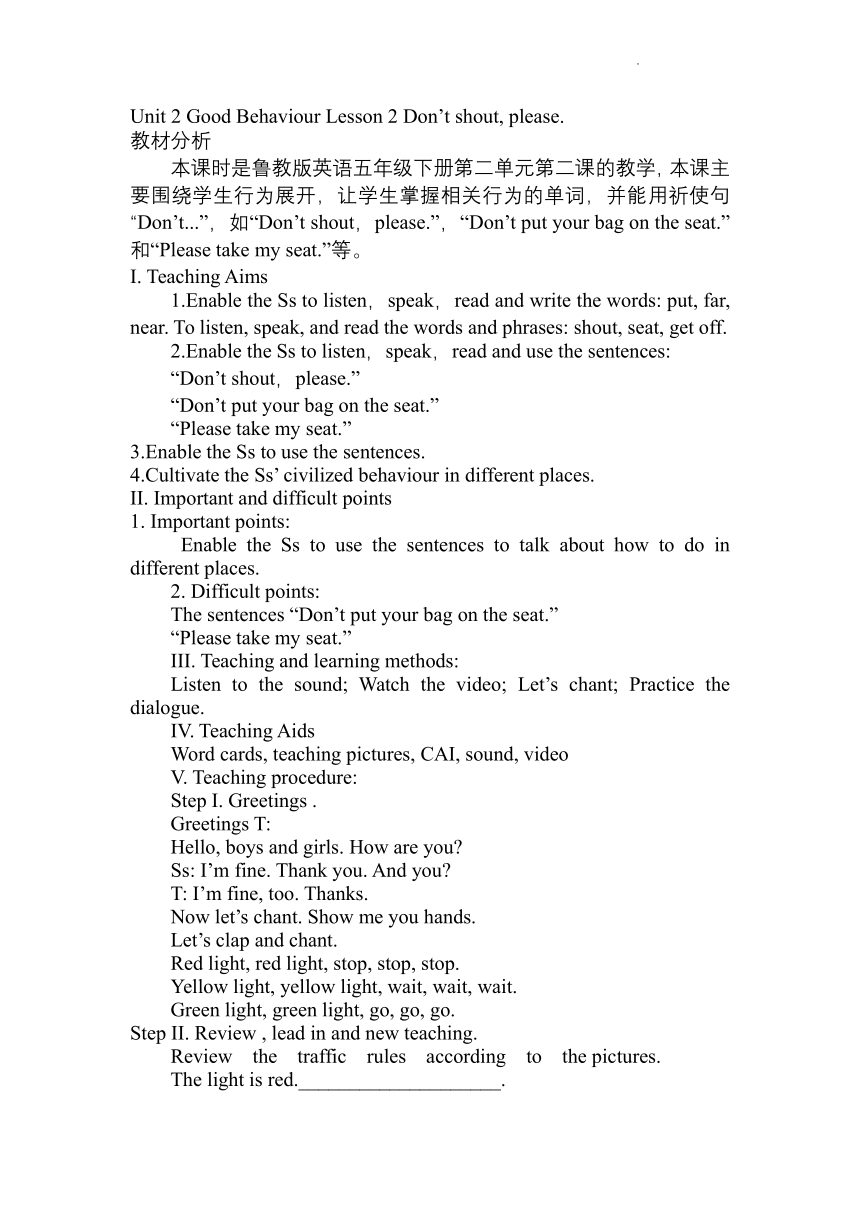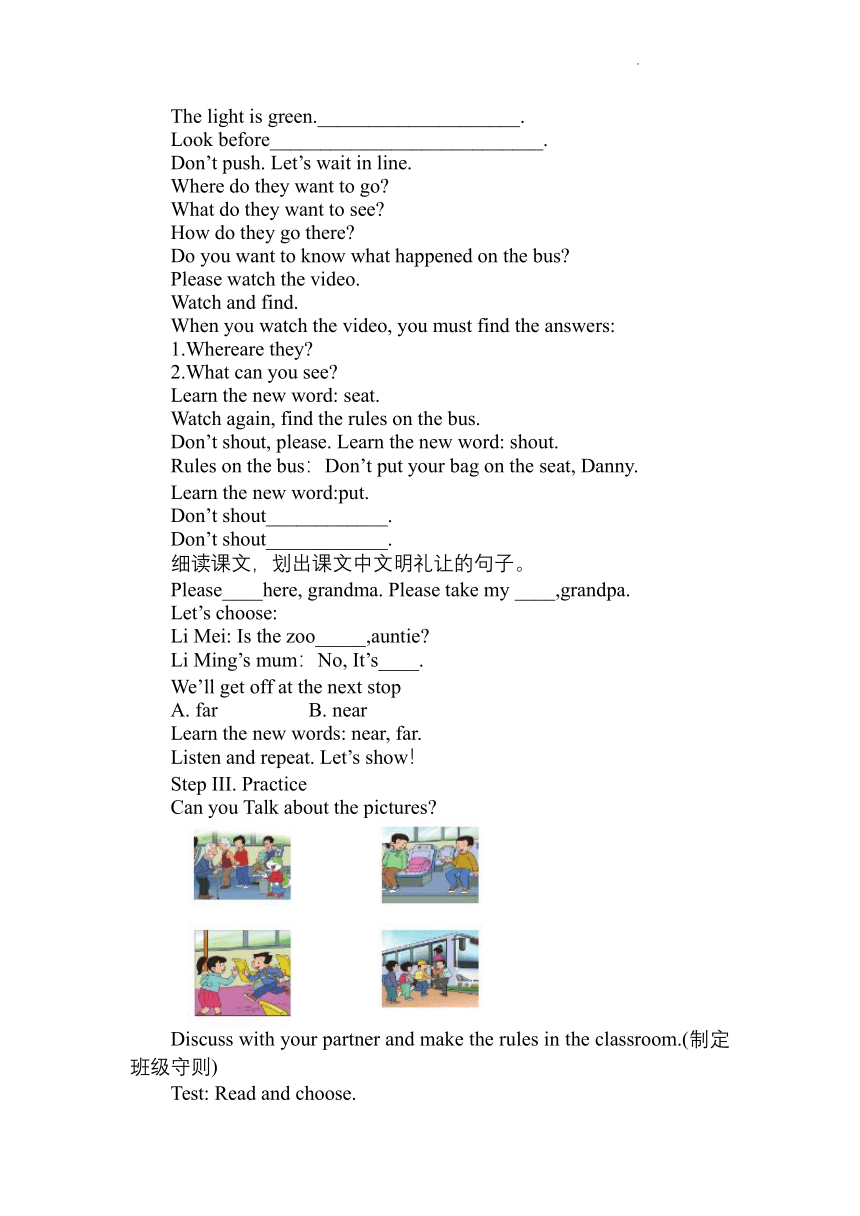Unit 2 Good Behaviour Lesson 2 Don’t shout, please.教案
文档属性
| 名称 | Unit 2 Good Behaviour Lesson 2 Don’t shout, please.教案 |

|
|
| 格式 | zip | ||
| 文件大小 | 181.4KB | ||
| 资源类型 | 教案 | ||
| 版本资源 | 鲁科版(五四制) | ||
| 科目 | 英语 | ||
| 更新时间 | 2022-04-12 00:14:00 | ||
图片预览


文档简介
Unit 2 Good Behaviour Lesson 2 Don’t shout, please.
教材分析
本课时是鲁教版英语五年级下册第二单元第二课的教学,本课主要围绕学生行为展开,让学生掌握相关行为的单词,并能用祈使句“Don’t...”,如“Don’t shout,please.”,“Don’t put your bag on the seat.”和“Please take my seat.”等。
I. Teaching Aims
1.Enable the Ss to listen,speak,read and write the words: put, far, near. To listen, speak, and read the words and phrases: shout, seat, get off.
2.Enable the Ss to listen,speak,read and use the sentences:
“Don’t shout,please.”
“Don’t put your bag on the seat.”
“Please take my seat.”
3.Enable the Ss to use the sentences.
4.Cultivate the Ss’ civilized behaviour in different places.
II. Important and difficult points
1. Important points:
Enable the Ss to use the sentences to talk about how to do in different places.
2. Difficult points:
The sentences “Don’t put your bag on the seat.”
“Please take my seat.”
III. Teaching and learning methods:
Listen to the sound; Watch the video; Let’s chant; Practice the dialogue.
IV. Teaching Aids
Word cards, teaching pictures, CAI, sound, video
V. Teaching procedure:
Step I. Greetings .
Greetings T:
Hello, boys and girls. How are you
Ss: I’m fine. Thank you. And you
T: I’m fine, too. Thanks.
Now let’s chant. Show me you hands.
Let’s clap and chant.
Red light, red light, stop, stop, stop.
Yellow light, yellow light, wait, wait, wait.
Green light, green light, go, go, go.
Step II. Review , lead in and new teaching.
Review the traffic rules according to the pictures.
The light is red.____________________.
The light is green.____________________.
Look before___________________________.
Don’t push. Let’s wait in line.
Where do they want to go
What do they want to see
How do they go there
Do you want to know what happened on the bus
Please watch the video.
Watch and find.
When you watch the video, you must find the answers:
1.Whereare they
2.What can you see
Learn the new word: seat.
Watch again, find the rules on the bus.
Don’t shout, please. Learn the new word: shout.
Rules on the bus:Don’t put your bag on the seat, Danny.
Learn the new word:put.
Don’t shout____________.
Don’t shout____________.
细读课文,划出课文中文明礼让的句子。
Please____here, grandma. Please take my ____,grandpa.
Let’s choose:
Li Mei: Is the zoo_____,auntie
Li Ming’s mum:No, It’s____.
We’ll get off at the next stop
A. far B. near
Learn the new words: near, far.
Listen and repeat. Let’s show!
Step III. Practice
Can you Talk about the pictures
Discuss with your partner and make the rules in the classroom.(制定班级守则)
Test: Read and choose.
Step IV. Extension
We should follow the rules.
As we know, in public we have to follow many rules.
Just like this. Look! Do you know the signs
Can you say something
You can say them with “Don’t ...”
What else do you know Let’s talk about.
Practise in groups.
What can you do or what can’t you do in classroom
Please talk about in group and make “rules in classroom”.
Talk about in class and write your opinions. Then put the them on the board. Wow! So many.
Let’s follow the rules. OK Let’s work together.
Good behaviour or bad behaviour.
Now look at some pictures about behaviour.
Can you be a judge
Let’s see which is good behaviour or which is bad behaviour.
OK! You did a good job. What about your behaviour Please talk about your behaviour after class.
Step V. Homework:
1.Listen Listen and repeat the text three times.
2.Make the rules about your class.
class.
Don’t ... ... ...
Let’s...
Unit2 Lesson2 Don’t shout, please.课后反思
本课是鲁科版英语五年级下册 Unit2 Lesson2 Don’t shout, please. 一课的教学,主要围绕学生行为展开,让学生掌握相关行为的单词,并能用祈使句“Don’t...”,如“Don’t shout.”,“Don’t put your bag on the seat.”和“Please take my seat.”等。本节课中,教师从学生行为的话题入手,根据五年级学生年龄的特点及身心发展规律,设计了各种语言操练活动和真实的语言交际活动,从而帮助学生掌握和运用所学语言。本节课主要关注了以下几个方面:
1.根据实情设定目标本单元的学习者我校五年级的学生。该班学生在英语学习上普遍存在浓厚的兴趣,在学习上有很大的自觉性,能够积极按照老师要求进行学习。作为五年级的学生他们在听说读写方面已经奠定了比较坚实的基础。所以我会把重点相应的放在知识的拓展和延伸上。
2.主线引导环环相扣本课以行为习惯为主线,所有教学环节与活动任务皆在此背景下展开。先由同学们在不同环境中可以做或不能做的事情内容进行自由对话并变成 chant自由练习,起到热身作用,调动起学生说英语的积极性和自信心;接着用生词“shout”来导入,让学生熟练运用祈使句“Don’t ...”并展示课题“Don’t shout, please.” 然后直接进入文本的学习:让学生带着任务学习文本对话,1. 完成句子;2. 回答问题。这样充分调动了学生的积极性,他们认真思考,积极参与,效果较佳。他们在练习中习得新知、运用新知并进行拓展延伸,每位学生都能得到个性的发展,进而体现了英语学科工具性与人文性的统一。
3.对话练习,形式多样在对话练习中,利用观看视频并跟读、小组合作和角色表演中练习,形式多样,改变枯燥无味的操练,学生兴致较高,取得较好的效果。
4. 操练引思步步提升本课中,教师紧紧围绕“behaviour”来开展一系列的讨论,引导学生谈论自己在公共场合、教室内不要做或可以做哪些事情。在此环节中,学生会从本节课及之前所学或贮备中的知识表达自己的观点,如:Don’t shout on the bus. Don’t swim in a lake. Don’t eat or drink in library.他们积极思维,在大脑中充分检索日常储备的尝试,踊跃发言,并通过小组合作的形式,讨论并记录下班级守则。最后,通过图片,快速判断了哪些行为是“Good behaviour”,哪些行为是“Bad behaviour”。这样,学生的和热情被充分地调动起来,同时又在不知不觉中为新知与旧知建立联系,为形成属于自己的知识网络奠定基础,学生在操练过程中听、说、读、写的综合能力得以提升。5. 拓展运用,提高能力把活动延续到课外,进一步巩固所学语言并运用到生活中,从而较好地达到课标所要求的“语言的运用”的要求,实现语用的目的。这一堂课结束后我进行了反思,我还是有以下几点需要改进:一是小组合作练习中写“班级守则”用时过长;二是视频打开出了点问题,年纪大了对多媒体的使用还有待熟练,得多向年轻人学习、请教。三是教学环节的衔接不太连贯,过度不大自然。四是对学生的引导略显生硬,师生配合得不太默契。今后,我应该注重在各个方面的预设,争取少出瑕疵,使课堂更加完美。
教材分析
本课时是鲁教版英语五年级下册第二单元第二课的教学,本课主要围绕学生行为展开,让学生掌握相关行为的单词,并能用祈使句“Don’t...”,如“Don’t shout,please.”,“Don’t put your bag on the seat.”和“Please take my seat.”等。
I. Teaching Aims
1.Enable the Ss to listen,speak,read and write the words: put, far, near. To listen, speak, and read the words and phrases: shout, seat, get off.
2.Enable the Ss to listen,speak,read and use the sentences:
“Don’t shout,please.”
“Don’t put your bag on the seat.”
“Please take my seat.”
3.Enable the Ss to use the sentences.
4.Cultivate the Ss’ civilized behaviour in different places.
II. Important and difficult points
1. Important points:
Enable the Ss to use the sentences to talk about how to do in different places.
2. Difficult points:
The sentences “Don’t put your bag on the seat.”
“Please take my seat.”
III. Teaching and learning methods:
Listen to the sound; Watch the video; Let’s chant; Practice the dialogue.
IV. Teaching Aids
Word cards, teaching pictures, CAI, sound, video
V. Teaching procedure:
Step I. Greetings .
Greetings T:
Hello, boys and girls. How are you
Ss: I’m fine. Thank you. And you
T: I’m fine, too. Thanks.
Now let’s chant. Show me you hands.
Let’s clap and chant.
Red light, red light, stop, stop, stop.
Yellow light, yellow light, wait, wait, wait.
Green light, green light, go, go, go.
Step II. Review , lead in and new teaching.
Review the traffic rules according to the pictures.
The light is red.____________________.
The light is green.____________________.
Look before___________________________.
Don’t push. Let’s wait in line.
Where do they want to go
What do they want to see
How do they go there
Do you want to know what happened on the bus
Please watch the video.
Watch and find.
When you watch the video, you must find the answers:
1.Whereare they
2.What can you see
Learn the new word: seat.
Watch again, find the rules on the bus.
Don’t shout, please. Learn the new word: shout.
Rules on the bus:Don’t put your bag on the seat, Danny.
Learn the new word:put.
Don’t shout____________.
Don’t shout____________.
细读课文,划出课文中文明礼让的句子。
Please____here, grandma. Please take my ____,grandpa.
Let’s choose:
Li Mei: Is the zoo_____,auntie
Li Ming’s mum:No, It’s____.
We’ll get off at the next stop
A. far B. near
Learn the new words: near, far.
Listen and repeat. Let’s show!
Step III. Practice
Can you Talk about the pictures
Discuss with your partner and make the rules in the classroom.(制定班级守则)
Test: Read and choose.
Step IV. Extension
We should follow the rules.
As we know, in public we have to follow many rules.
Just like this. Look! Do you know the signs
Can you say something
You can say them with “Don’t ...”
What else do you know Let’s talk about.
Practise in groups.
What can you do or what can’t you do in classroom
Please talk about in group and make “rules in classroom”.
Talk about in class and write your opinions. Then put the them on the board. Wow! So many.
Let’s follow the rules. OK Let’s work together.
Good behaviour or bad behaviour.
Now look at some pictures about behaviour.
Can you be a judge
Let’s see which is good behaviour or which is bad behaviour.
OK! You did a good job. What about your behaviour Please talk about your behaviour after class.
Step V. Homework:
1.Listen Listen and repeat the text three times.
2.Make the rules about your class.
class.
Don’t ... ... ...
Let’s...
Unit2 Lesson2 Don’t shout, please.课后反思
本课是鲁科版英语五年级下册 Unit2 Lesson2 Don’t shout, please. 一课的教学,主要围绕学生行为展开,让学生掌握相关行为的单词,并能用祈使句“Don’t...”,如“Don’t shout.”,“Don’t put your bag on the seat.”和“Please take my seat.”等。本节课中,教师从学生行为的话题入手,根据五年级学生年龄的特点及身心发展规律,设计了各种语言操练活动和真实的语言交际活动,从而帮助学生掌握和运用所学语言。本节课主要关注了以下几个方面:
1.根据实情设定目标本单元的学习者我校五年级的学生。该班学生在英语学习上普遍存在浓厚的兴趣,在学习上有很大的自觉性,能够积极按照老师要求进行学习。作为五年级的学生他们在听说读写方面已经奠定了比较坚实的基础。所以我会把重点相应的放在知识的拓展和延伸上。
2.主线引导环环相扣本课以行为习惯为主线,所有教学环节与活动任务皆在此背景下展开。先由同学们在不同环境中可以做或不能做的事情内容进行自由对话并变成 chant自由练习,起到热身作用,调动起学生说英语的积极性和自信心;接着用生词“shout”来导入,让学生熟练运用祈使句“Don’t ...”并展示课题“Don’t shout, please.” 然后直接进入文本的学习:让学生带着任务学习文本对话,1. 完成句子;2. 回答问题。这样充分调动了学生的积极性,他们认真思考,积极参与,效果较佳。他们在练习中习得新知、运用新知并进行拓展延伸,每位学生都能得到个性的发展,进而体现了英语学科工具性与人文性的统一。
3.对话练习,形式多样在对话练习中,利用观看视频并跟读、小组合作和角色表演中练习,形式多样,改变枯燥无味的操练,学生兴致较高,取得较好的效果。
4. 操练引思步步提升本课中,教师紧紧围绕“behaviour”来开展一系列的讨论,引导学生谈论自己在公共场合、教室内不要做或可以做哪些事情。在此环节中,学生会从本节课及之前所学或贮备中的知识表达自己的观点,如:Don’t shout on the bus. Don’t swim in a lake. Don’t eat or drink in library.他们积极思维,在大脑中充分检索日常储备的尝试,踊跃发言,并通过小组合作的形式,讨论并记录下班级守则。最后,通过图片,快速判断了哪些行为是“Good behaviour”,哪些行为是“Bad behaviour”。这样,学生的和热情被充分地调动起来,同时又在不知不觉中为新知与旧知建立联系,为形成属于自己的知识网络奠定基础,学生在操练过程中听、说、读、写的综合能力得以提升。5. 拓展运用,提高能力把活动延续到课外,进一步巩固所学语言并运用到生活中,从而较好地达到课标所要求的“语言的运用”的要求,实现语用的目的。这一堂课结束后我进行了反思,我还是有以下几点需要改进:一是小组合作练习中写“班级守则”用时过长;二是视频打开出了点问题,年纪大了对多媒体的使用还有待熟练,得多向年轻人学习、请教。三是教学环节的衔接不太连贯,过度不大自然。四是对学生的引导略显生硬,师生配合得不太默契。今后,我应该注重在各个方面的预设,争取少出瑕疵,使课堂更加完美。
同课章节目录
- Unit 1 Winter Holidays
- Lesson 1 What did you do in the holidays?
- Lesson 2 I didn’t ski.
- Lesson 3 Everyone was happy that day.
- Lesson 4 Again ,please!
- Unit 2 Good Behaviou
- Lesson 1 Let’s stop and wait
- Lesson 2 Don’t shout,please.
- Lesson 3They are in the zoo.
- Lesson 4 Again ,please!
- Unit 3 Health
- Lesson 1 What’s wrong with you?
- Lesson 2 How are you feeling today?
- Lesson 3 How can we keep healthy?
- Lesson 4 Again ,please!
- Unit4 Neighbourhood
- Lesson 1 He lives next to me.
- Lesson 2 Is there a gym around?
- Lesson 3 They are having lots of fun.
- Lesson 4 Again ,please!
- Unit 5 Country Life
- Lesson 1 There is a river near the village.
- Lesson 2 How many ducks do you have?
- Lesson 3 He goes to school by school bus.
- Lesson 4 Again ,please!
- Unit 6 Plan for the Summe
- Lesson 1 What are you going to do this summer holi
- Lesson 2 You’d better take an umbrella.
- Lesson 3 Get ready for a new school life!
- Lesson 4 Again ,please!
